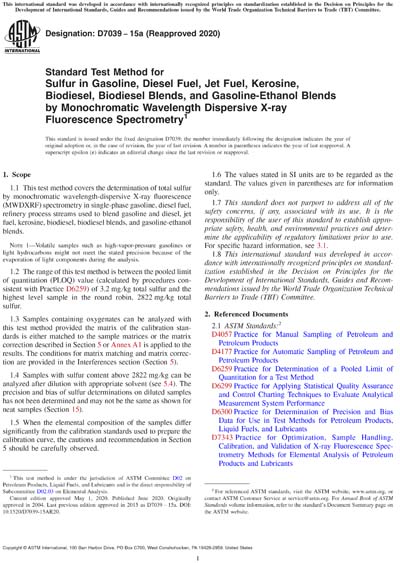Most recent
ASTM D7039-15a(2020)
Standard Test Method for Sulfur in Gasoline, Diesel Fuel, Jet Fuel, Kerosine, Biodiesel, Biodiesel Blends, and Gasoline-Ethanol Blends by Monochromatic Wavelength Dispersive X-ray Fluorescence Spectrometry
1.1 This test method covers the determination of total sulfur by monochromatic wavelength-dispersive X-ray fluorescence (MWDXRF) spectrometry in single-phase gasoline, diesel fuel, refinery process streams used to blend gasoline and diesel, jet fuel, kerosine, biodiesel, biodiesel blends, and gasoline-ethanol blends.
Note 1: Volatile samples such as high-vapor-pressure gasolines or light hydrocarbons might not meet the stated precision because of the evaporation of light components during the analysis.
1.2 The range of this test method is between the pooled limit of quantitation (PLOQ) value (calculated by procedures consistent with Practice D6259) of 3.2 mg/kg total sulfur and the highest level sample in the round robin, 2822 mg/kg total sulfur.
1.3 Samples containing oxygenates can be analyzed with this test method provided the matrix of the calibration standards is either matched to the sample matrices or the matrix correction described in Section 5 or Annex A1 is applied to the results. The conditions for matrix matching and matrix correction are provided in the Interferences section (Section 5).
1.4 Samples with sulfur content above 2822 mg/kg can be analyzed after dilution with appropriate solvent (see 5.4). The precision and bias of sulfur determinations on diluted samples has not been determined and may not be the same as shown for neat samples (Section 15).
1.5 When the elemental composition of the samples differ significantly from the calibration standards used to prepare the calibration curve, the cautions and recommendation in Section 5 should be carefully observed.
1.6 The values stated in SI units are to be regarded as the standard. The values given in parentheses are for information only.
1.7 This standard does not purport to address all of the safety concerns, if any, associated with its use. It is the responsibility of the user of this standard to establish appropriate safety, health, and environmental practices and determine the applicability of regulatory limitations prior to use. For specific hazard information, see 3.1.
1.8 This international standard was developed in accordance with internationally recognized principles on standardization established in the Decision on Principles for the Development of International Standards, Guides and Recommendations issued by the World Trade Organization Technical Barriers to Trade (TBT) Committee.
Content Provider
ASTM International [astm]






